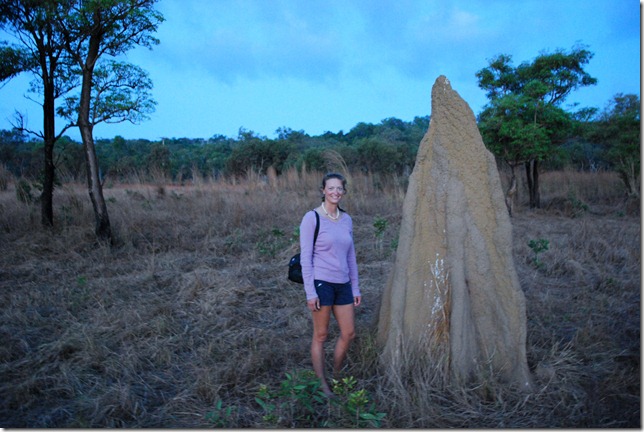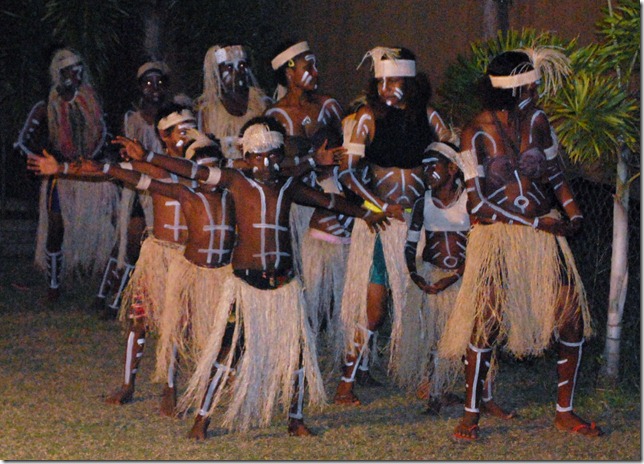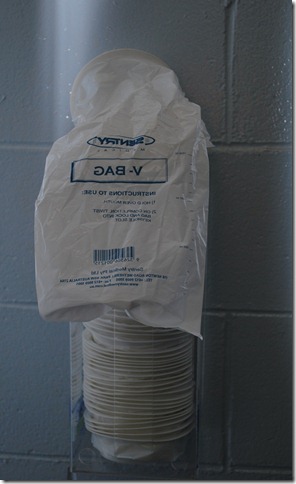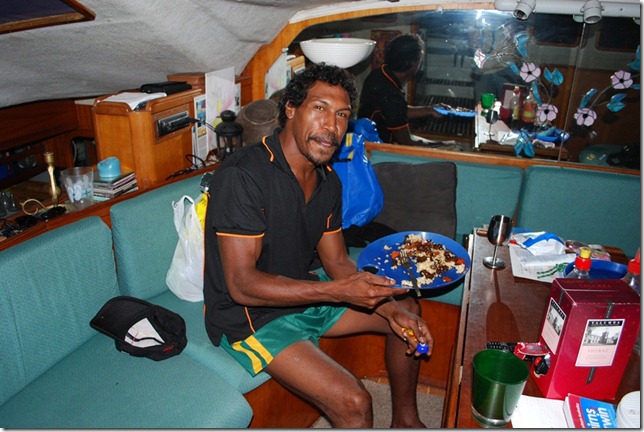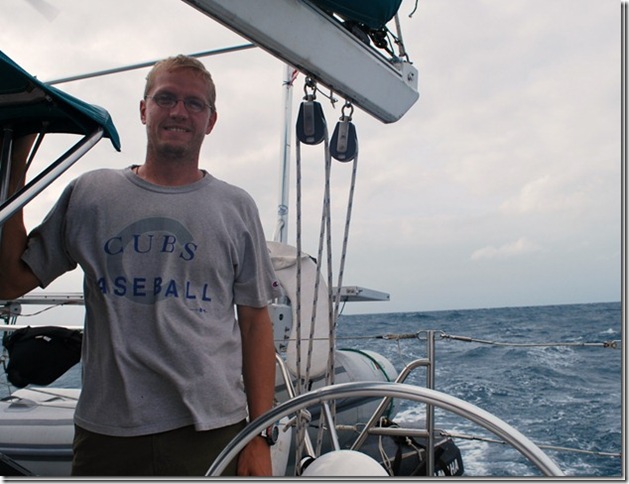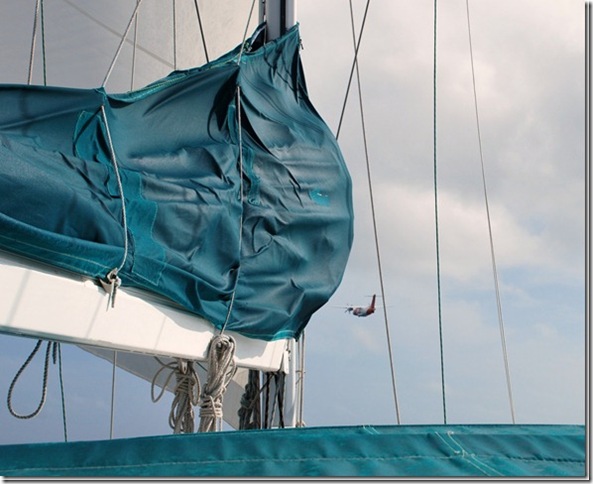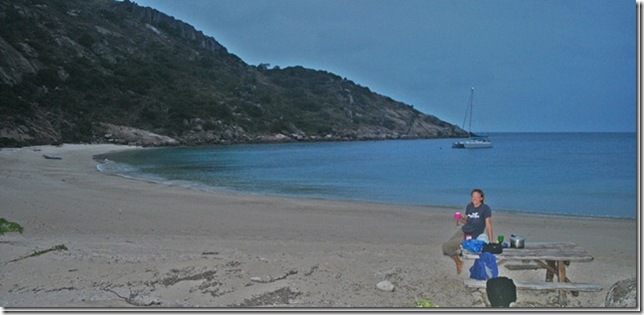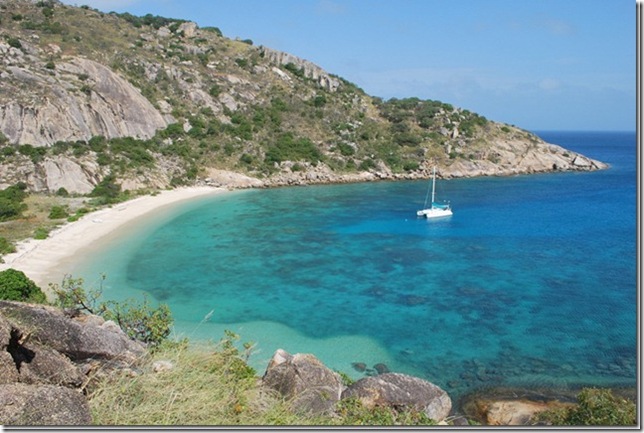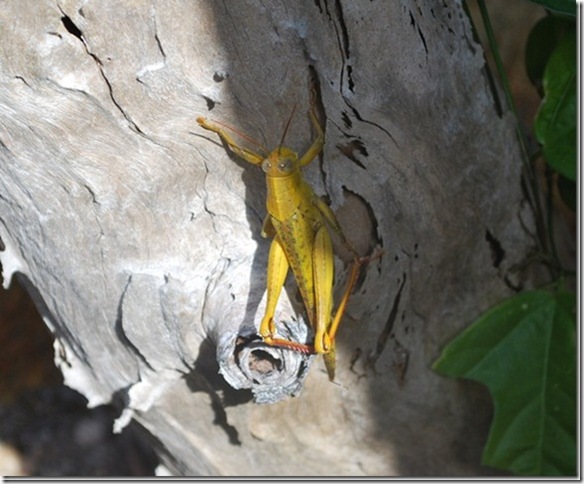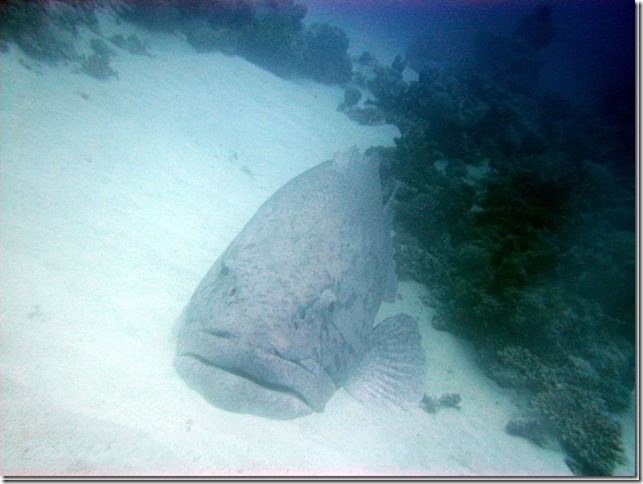Lat: 10 48.643′ S
Long: 141 43.436′ E
It’s Thursday afternoon, and we are sailing toward the Wessel Islands in pretty ideal conditions. The water just north of the Northern Peninsula Area (NPA) is a beautiful turquoise dotted with little green islands, and we are spinnaker sailing with 15 knots from the southeast.
We enjoyed our brief stay in Seisia. We lazed around on Tuesday morning, apparently still catching up after two nights at sea, and then went ashore for internet (high speed at the RV park office — oh yeah) and a bit of provisioning. That evening we went in search of an ant hill to photograph, and we didn’t have to walk too far to find some taller than us. (Dallas just had to show this city girl how to scoot through a barbed wire fence.) It really blows my mind how cooperative these tiny little ants must be to achieve something so large.
We had already walked a fair distance toward the nearby metropolis of Bamaga and decided to try to hitch-hike the rest of the way to check out "the haps" at the tavern. We had only waited 5 minutes for a ride the day before but didn’t have any luck on this occasion, probably because it was almost completely dark! I can see how nighttime is not well suited for getting a lift from strangers. We’re new at this.
We stopped at the wharf on the way back to the boat and found several locals and holiday-makers fishing. We spoke to a really nice mother and son from Melbourne who showed me how to use a jigger to catch bait fish (there were hundreds of them swimming right next to the wharf). I also learned a new word from them to add to my ever-growing list of Aussie/Kiwi/British slang: "grass". No, they weren’t offering us illegal substances, they were simply saying how cool our trip around the world was — "that’s grass!" They were in the midst of a 6-week family holiday and had driven their 4×4 up through the center of Oz. Their two boys are able to get school credit for the blogs that they are writing along the way, which sounds like a great idea to me.
They told us about a traditional Aboriginal dance performance that was to take place the following night at the local fishing club, and after some deliberation, Dallas and I decided to stick around for another day to check it out. It turned out to be a good decision, not so much for the dancing (although it was cool) but for the time that we were able to spend with another Aussie, a 50-something liveaboard named Brett. He spent several years in the States, including a few years working as a pilot for Continental in Houston. As that is the port listed on the stern of our boat, he was naturally inclined to come by and say hello (while Dallas was working on the carburetor of the outboard again!). He brought over a few cold beers, and he and Dallas yarned away (see what I mean about the slang?) about everything boat-related, from the proper way to set the anchor to the loss of .3 amps for every amp put into the house bank (this was news to me). He was bright and down-to-earth and had a couple of hair-raising stories from his pilot days. He also had insight into the differences between American and Aussie cultures. For example, he raised his step-sons in Oz so that they would learn how to be self-sufficient (e.g., to fish and hunt) and then sent them to the U.S. to develop their real-world work ethic. Anyway, he was great company, and I could tell that Dallas was really pleased to have someone other than me to talk to for the first time in 10 days!
Regarding the dance performance last night, it was in fact very traditional, but the dancers were young boys (aged 6 or 7) and teenage girls (aged 10-17), so it wasn’t like watching the professionals in Polynesia. I tried talking to one of the teenage girls after the performance about the absence of guys. She was busy texting and just said "they’re at home". The Aboriginal situation here is so complex and long-standing that I would not do it justice by trying to describe it in a short blog, but what I’ve heard about the history of the government’s attempts to remedy the problem (e.g., the "Stolen Generations", the massacre in Tasmania) is pretty shocking.
We have about 300 miles to go to the Wessels, which are supposed to be pristine and beautiful. We haven’t seen any awe-inspiring, natural beauty for a whole 4 or 5 days (must be a record!), so we’re looking forward to it.
We’ve made it over “The Tip”, as the locals call Cape York, the northernmost point of the Australian mainland. We covered the 320+ nm distance from Lizard Island to Cape York in about 48 hours, giving us an average speed of better than 6.6 knots, which is probably a record for us. All we had to do is unfurl the jib a couple minutes after leaving Lizard Island and then gibe occasionally when our course changes through the GBR caused the following winds to come from the opposite quarter. We had plenty of wind the whole time, with the strongest winds coming the second night – sustained 40 knots for a bit with gusts over 50 knots. The boat really did well, though, and the reefs and islands kept the seas from getting as big as they would have if we’d been offshore, so overall we were pretty comfortable.
Passing through the Torres Strait is often a bit of a nightmare for people because of the strong tidal currents and shipping traffic, but we were fortunate to have a great passage. We were planning to anchor at Albany Island, just before the straits to get some sleep and wait for good tide conditions and daylight, but our timing was perfect, so we just kept sailing. We arrived just after sunrise, with the wind at our back and the tides in our favor as well. We were arriving just after a low tide, so the current would be running with both us and the wind (against us would have slowed us and against the wind would have resulted in steep seas). It was also a half moon, so the tides (and currents) weren’t as extreme, and this was the second high tide of the day, which was much smaller (again, less current) than the day’s earlier high tide. Pretty good luck overall. As we sped toward the Cape doing 7 knots on just the jib, we enjoyed sunny skies and light seas that left the boat feeling like it was at anchor.
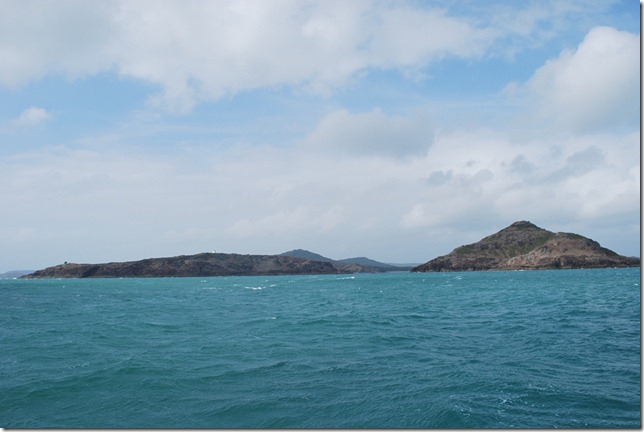 Cape York about a mile away between Ecobar (l) and York (r) Islands
Cape York about a mile away between Ecobar (l) and York (r) Islands
By early afternoon, we’d entered the Endeavor Strait and dropped anchor at Seisia (SAY-see-uh) where we were planning to pick up a few fresh groceries. Seisia is our first real outback experience, and our first day here has been an interesting one. The mainland is covered in brush and red dirt. As soon as we went ashore we started seeing 4x4s with snorkels for crossing outback rivers and it seemed like half the men were wearing the stereotypical Aussie outback hats (think Crocodile Dundee). Over half of the community of Seisia consists of an RV campground with 16 sites. A wharf where a supply ship and ferry stop, a grocery store, a gas station, mechanic/junkyard, and a few houses and trailers make up the rest of the greater metropolitan area. There are two common signs around town. One is posted at the supermarket and gas station and states that by order of the local council, no children will be served between 9am and 3pm Monday through Friday (apparently school is really no fun here). The second one is an ad for a local politician that says “No wild rivers without our consent”. We’re still trying to figure out that that one means.
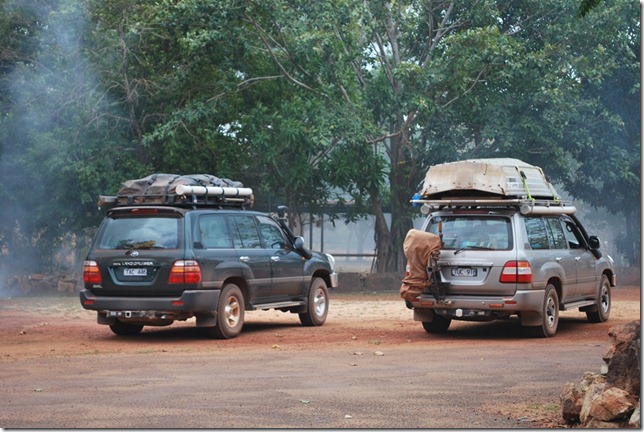 The “tinnie” (aluminum boat) on the 4×4 is pretty common
The “tinnie” (aluminum boat) on the 4×4 is pretty common
We decided to try hitching a ride to Bamaga (BAM-uh-guh seems to be close), a few miles away, and after watching some free range horses cross the road in front of us, we were picked up by a couple of women in a youth club truck who informed us that the giant piles of dirt we’d seen on an island on the way in and that we were passing in the truck were anthills. We saw one on the way that was about 7 feet high and 3 feet or so wide at the base. The ants aren’t anything special in terms of their size, but the anthills are something to see.
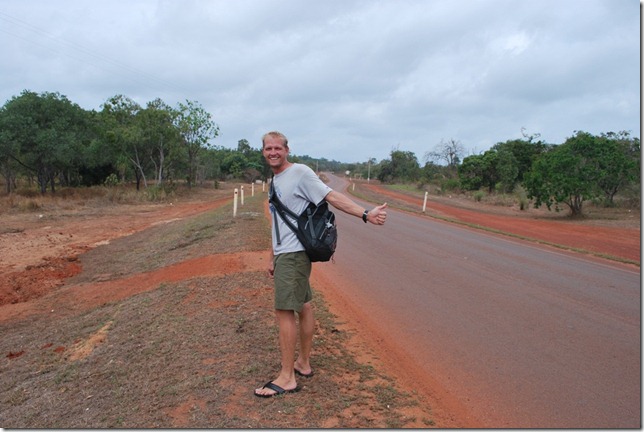 Hitching is easy work here – the place is small and people are friendly
Hitching is easy work here – the place is small and people are friendly
Bamaga is something of the local big city, with a larger grocery store, a bar, a bakery, and a general store, a resort, and a post office. The largest and nicest buildings in Bamaga seem to be the local government and unemployment offices. We asked about some internet access where we could use our computer and it turns out that there are only two internet cafes/hotspots in the 5 communities here. It was definitely starting to feel more like the islands than a first-world country. After checking prices at the grocery store (try $7.50 for a tube of Pringles) we wandered over to the bar. Of course they were playing MTV, just to make sure that even the most remote places of the world can recognize Brittney Spears and her latest #1 video. The rules posted in the bar were numerous and seemed to indicate that drinking was a bit of a problem, presumably primarily with the local aborigine population. There was a list of bad behavior, complete with the associated ban times for each offence (e.g., refusing to leave when asked is a 3 month ban), a notice that the associated drive-though liquor store would no longer be serving patrons on foot, rules against falling asleep and begging for money, cigarettes, or beer, and a list of the limit for in-bar and takeaway alcohol purchases. I took a moment to use the restroom and found something I’d never seen before – a stack of bags to vomit in. Apparently this is a big enough problem that the bar has purchased the bags and put a dispenser in the bathroom. The funniest part is that there are detailed instructions on the bags about how to vomit in them and then throw them away, but all the instructions are printed backwards, as though you’re supposed to read them with your rearview mirror. Of course there’s no mirror in the bathroom and the bags are presumably for the severely intoxicated. Hopefully they can either backwards even when drunk or somehow manage it without detailed instructions. Needless to say, we’re disappointed to be here on a Monday afternoon instead of a weekend night when we could apparently expect to be in for some pretty entertaining people-watching.
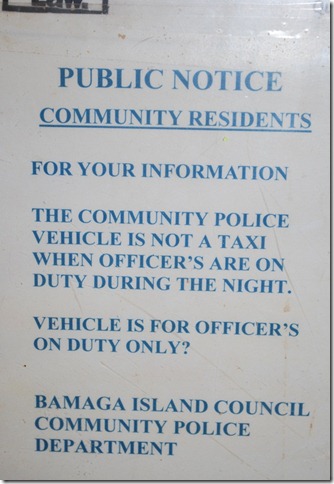 One of my all-time favorite signs
One of my all-time favorite signs
We eventually met a local islander/aborigine named Noel (NOLE) who had a lot of interesting stories about life here in the far north. He joined us for dinner on the boat, which was delayed just a bit by having to remove and clean the carburetor again. Apparently the islands between here and Papau New Guinea were populated by people now called islanders who were different in terms of language and cultural from the aborigines of the mainland, although some intermixing did occur. For instance, Noel’s Dad is an islander from Thursday island, while his mother is from the mainland. When we asked him how many brothers and sisters he had, he said “heaps” – some in each of the local communities. Many of his stories were about how the natives put meat on the table. They hunt dugongs (manatees) by simply taking a dinghy out and drifting along until the curious dugong comes nearby and then they spear it and take it back with a larger dinghy. Lobsters are plentiful at Cape York itself, where they brave the rough seas and strong currents to freedive and catch them. Sea turtles are plentiful and are taken occasionally as well, but only a couple of fish can be speared at a time before sharks become a risk. Last night Noel was planning to go crabbing with friends at midnight, when the moon rises and the crabs apparently come out to forage on the riverbank. Wild cows and bulls can be shot near Weipa (a five hour boat ride). Apparently most of the livestock ranges free, but the cows and bulls with no brands are wild and for the taking. In some places they’re right up on the beach and they’re able to shoot them from the boat, but if they go to hide in the dense, impenetrable scrub, they use another trick. They start a grass fire and burn a large area near the edge of the scrub. A couple of days later, green shoots of grass appear in the burned areas and the cows and bulls, who have a serious craving for fresh green grass, wander out just before sunrise to enjoy the delicacy. That’s when they become the delicacy for friends and family. Kangaroos are hunted as well, but Noel says that even though croc tail tastes like chicken they generally don’t hunt it because it’s too dangerous. He’s seen a man get killed by a croc. Apparently the guy was a long time croc hunter who risked swimming from a river shore to a waiting ferry at night and only made it part way. Noel and others found his body underwater where the croc had brought it back to stash it and eat it later. Crocs are apparently protected now, but it sounds like there are plenty of people who still try to kill them when possible to avoid becoming prey at some point in the future. After all the croc stories and the strong currents here I was glad that the repaired outboard ran well when I dropped Noel off at shore to go crabbing. In the dark, the wharf lights showed at least 20 people fishing and pulling squid to make calamari.
Noel also said that many people believe there are “wild people” (aborigines living in the traditional way) out in the bush. One look at a map of the area makes it clear there’s plenty of unoccupied space and there have certainly been plenty of reasons for mistrust between the natives and whites in the past. He says sometimes when they’re out in the bush acting as rangers or hunting, they find unexplained fires that are still warm, see smoke, or see people in the distance. That one may be a tall tale, but this place is definitely a far cry from Cairns, with its blocks of tourist shops and restaurants and fleet of boats that carry hundreds of tourists daily.
Lat: 12 48.453′ S
Long: 143 38.136′ E
It’s about midnight on Sunday, and the half moon has just now made an appearance. I’m relieved to see its glow as it was getting a little spooky knowing that there were reefs on either side of us but seeing nothing but a few hazard lights that appeared deceptively close. I trust the charts for this area, but in the pitch black of darkness, it’s easy for one’s mind to start to wonder about the chances of running across reef that isn’t marked… It doesn’t help that earlier today I noticed a stripe of green water running parallel to our course, indicating that there was shallow water there even though this wasn’t suggested on the chart. (Dallas noticed the same phenomenon an hour or so later and thinks it’s an effect of the sunlight.) To top it off, we are in a shipping channel and have had multiple 850′ container ships pass by us at 15-20 knots — the force at which they could hit us is another fun thing to ponder in case we start to get bored!
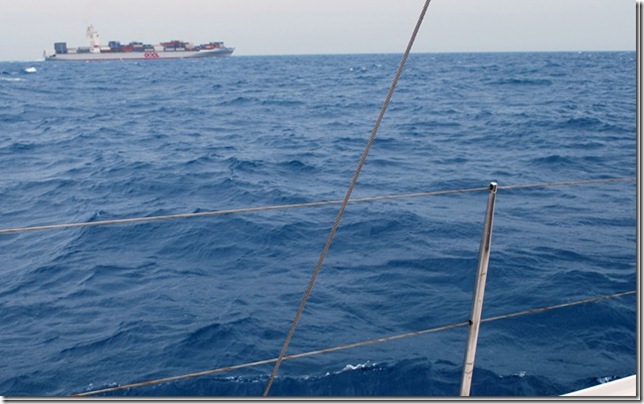 This 600-footer was less than half a mile away
This 600-footer was less than half a mile away
Cruising along the coast (and especially here in the GBR) definitely requires more alertness and maneuvering than our typical set-it-and-forget-it style of open ocean sailing, and I appreciate the challenge. The only annoying part is that our depth meter is set to sound an alarm when we cross above or below the 100′ mark, and since we are in relatively shallow contours near the reef, we have crossed that mark at least 100 times today! Dallas tried to change the settings on the alarm, but the button required to do so isn’t working, so in the meantime, we are getting a bit of exercise walking back and forth to press the offset button.
All in all, it has been a quiet, relaxing day, as seems to be the norm with just the two of us on board. I cut Dallas’ hair in the cockpit this morning, and it looks pretty good if I do say so myself. We had planned on taking a bath in our private bay before setting sail, but the research divers were already here and in the water by 7:30, so instead of flashing them we waited until we were offshore to shower. I went for the saltwater bucket shower (followed by freshwater rinse), while Dallas went freshwater only from the bug sprayer. It’s a matter of personal preference of course, but for me and my long hair it is better to have enough water to get really soaked. My favorite method is still getting in the water and being dragged behind the boat while holding on to the swim ladder, but even with my sailor arms (so I’m told) I wasn’t going to try to hold on while going 6 knots.
We’ve been averaging 6-7 knots with winds from astern and hardly feel it. We had talked about making a short (about 150 mile) passage to start with but both agree that we might as well carry on to Cape York (the northernmost point of Oz) for a quick stop since the wind and seas are treating us well. We will probably also make Darwin a short stop in order to spend more time in Indonesia. Dallas has been reading about Bali and Lombok and getting excited about how cheap everything is there — meals for 2 for $11, hotels for only $7/night! At this point, we are in agreement that we should spend our time there instead of spending a week or two traveling through the Outback, as he says, "to see a rock" (Uluru or Ayers Rock in the center of Oz). We (and cruisers in general) are suckers for cheap food and entertainment. However, we’re not done with Oz yet, and I’m still hoping to see some good ol’ Aussie sights like kangaroos as well as less touristy sights such as the Aboriginal villages up in the Northern Territory.
I’m finishing this on Monday morning. (In the meantime, I got a bit of sleep and watched "The Holiday"–cute!) We just got buzzed by the Australian Customs’ plane. They performed two flyovers, getting about 100′ feet from the boat before calling on the radio to ask us a few questions about the boat, our last/next port of entry, etc. We’d already heard from other cruisers that these flyovers were common here, though, so we’re not feeling too special. They seem to cover all their bases in protecting these waters.
Getting buzzed
Lat: 14 38.846′ S
Lon: 145 27.253′ E
I guess Lizard Island isn’t technically part of the GBR, but it’s here in the middle of it and our beautiful mooring spot in Mermaid Bay is surrounded by coral and marine life. Last night’s dinner was a bit of an adventure. There are actually two picnic tables on the beach here – one in the middle of the beach and one at the left side of the beach at the base of a rocky cliff. I set dinner up as a picnic and we paddled ashore just before sunset. Right after taking pictures of our beautiful, private dinner on the beach and pouring a couple glasses of wine to go with the pasta and garlic bread it started raining. We’re used to this sort of thing, so into the waterproof bag went the camera, etc. and we headed for the dinghy. Right as we got to the dinghy the rain stopped and we decided to give it a second try. We were able to finish dinner and enjoy a nice evening with only light sprinkles. It’s been rainy and windy much of the time here in Australia, but I guess the good side is that in addition to having to work during the week, the weather has kept a lot of the locals ashore and we’ve had some great spots to ourselves. Nobody else has even tried to pick up one of the public moorings we’ve been using.
This morning we made plans to hike up both of the ridges on either side of the bay. The east ridge offered a good chance for pics of the boat with the sun behind us so we headed that way first. We changed from bare feet to sock and shoes (there was no trail so we consented to give the flip-flops the day off) on some rocks at the edge of the water, and I promptly slipped off of the first rock I stepped on and got both shoes soaked. Great start. The climb up the first ridge was slow and a little steep, but not too difficult. I kept thinking of all the bad things in Australia that you could suddenly come across, but hoped that an offshore island is a bit safer. We stayed on the large rocks as much as possible, but had to walk up through the grass at times as well. The grass wasn’t tall, but it was so thick that you couldn’t see what was underneath; only after stepping down on it did you learn whether it was a rock, a hole, or loose hillside. A slow 15 minutes or so of climbing put us at the top of the ridge where we could see a group of tourists being dropped off on the beach below. They all donned wetsuits and were obviously enjoying the snorkeling. The view down to the small bay was beautiful enough to make the Australia month of next year’s calendar.
We’re still in the midst of places that Captain Cook visited, including the nearby mainland town of Cooktown. His ship, the Endeavour, wandered into the maze of reef that make up the GBR and was nearly lost. After running aground on on a reef (remember there were no charts to reference), they were lucky enough to work their way off and limp up the newly christened Endeavour River to a spot that became Cooktown. When they were ready to leave, Cook sailed to Lizard Island and climbed the peak here to sight out a pass through the GBR and into the open water of the Coral Sea.
We tramped back down the ridgeline, along the rocky waterline, across the beach, and over to the western ridge. We were really wanting some exercise after several days aboard, but we were also hoping to get a view of the other side of the island. After climbing over the large rocks along the waterline, we rounded the point and realized that seeing the other side of the island was going to be more work than we’d thought, so we turned back after taking some pics of a really colorful bird that looked a bit like a kingfisher or woodpecker. All along the walk we kept startling really big grasshoppers. Anyone that’s ever been around large grasshoppers knows they can jump and fly, but don’t really seem to navigate all that well. Once or twice they actually ended up flying into us while presumably trying to get away.
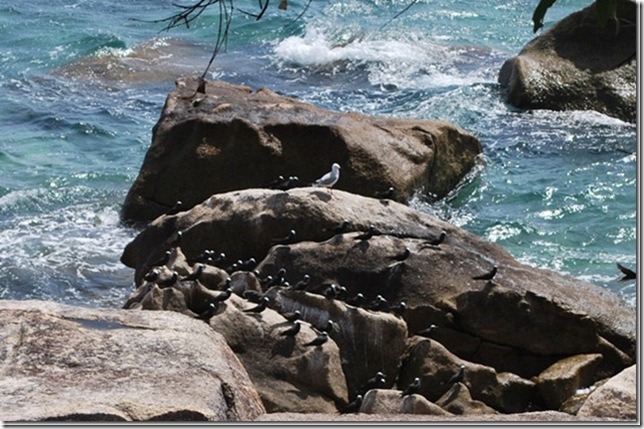 Seabirds taking a break from fishing
Seabirds taking a break from fishing
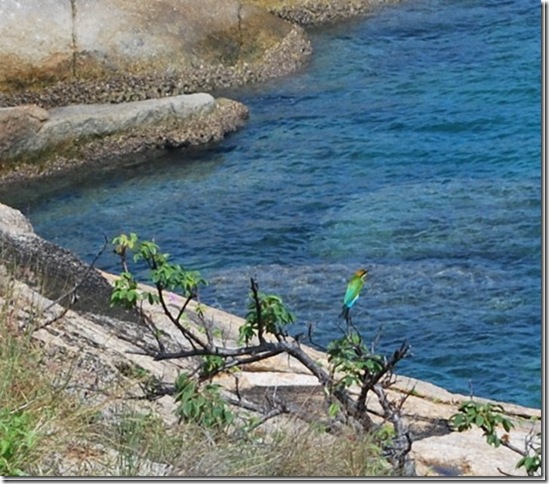 One of the more colorful birds we’ve seen
One of the more colorful birds we’ve seen
Back on the beach we had a short chat with the tourist family, which happened to be Americans from Annapolis, and headed back to the boat for lunch and a pre-dive nap. The diving and snorkeling was supposed to be great here, but whether it’s my general dislike for being wet, diving fatigue, or just plain laziness, I didn’t really feel up for it. Luckily Lauren isn’t one to miss a dive opportunity so we eventually suited up and started swimming over to the reef that juts out off of the rocky eastern point of the bay. The plan was to swim around the reef over to the open water side where we expected to find a wall, and I hoped to find a healthy collection of fish (quite a few birds were fishing this region of the channel when we came in). The dive started out completely unspectacular – small fish we were familiar with, lots of dead and brown coral. Just as we rounded the corner of the reef, though, things started to pick up. We saw a small stingray, a 4-foot white-tip shark and a really big angelfish. The coral became more colorful, plentiful, and much larger. We came across a sort of sandy road that seemed to offer a shortcut to the open water side of the reef, so we followed it and before long came across a 5-foot white-tip shark. This one was sleeping on the bottom and didn’t even budge as we got as close as we felt comfortable (25 feet or so) to take a couple pictures. Not much farther along, a narrow chasm offered a look into deep water beyond. I stuck my head in and the current swept me back, but I could see some amazingly colorful and large fish, so I motioned for Lauren to lead the way since she had the camera. Once we made it through we were in a different world. The fish that were waiting for us are in our dive atlas as “Indian Ocean Sweetlips” and were nearly 2 feet long. I’d been flipping through the book today, seen the picture, and said to myself, “Well, there’s one colorful fish I don’t think we’ve ever seen,” and like magic here they were. We turned the corner and were amazed by the collection of large fish, including a large potato cod, a really big Napolean/Maori/Humphead Wrasse (you’ve gotta google a pic of one to really appreciate how large and interesting-looking they are) and several large schools of big fish. It was like swimming through a tropical fish tank with a gorgeous, vibrant wall of coral to our left. We ended up spending 50 minutes underwater; what started as a ho-hum dive had turned into one of our favorites. This time, the underwater camera lens didn’t fog up, so Lauren’s pics turned out really well, including the video of the “Indian Ocean Sweetlips” (someday we’ll be back to the land of internet again and you’ll see what we’re talking about).
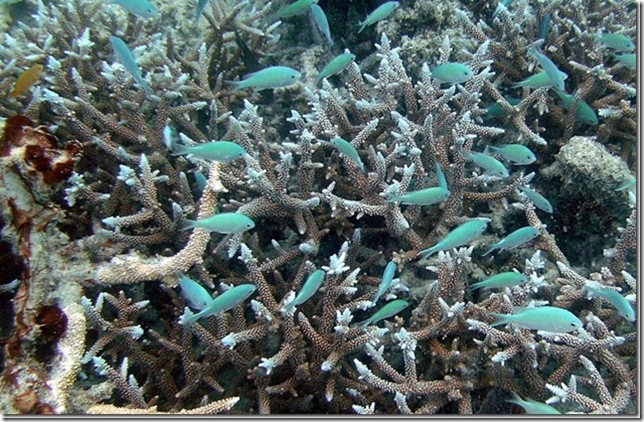 Small colorful fish in the staghorn coral
Small colorful fish in the staghorn coral
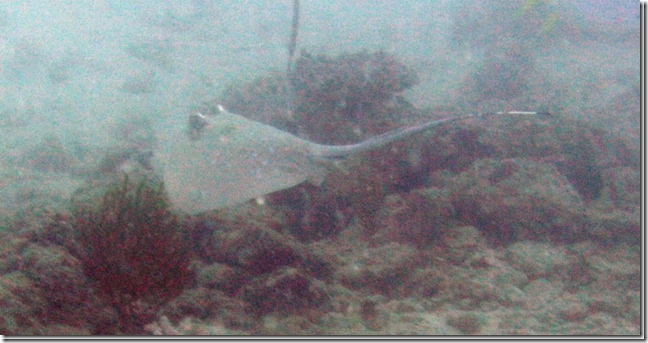 I just can’t see a stingray anymore without having “Steve Irwin” flash into my head
I just can’t see a stingray anymore without having “Steve Irwin” flash into my head
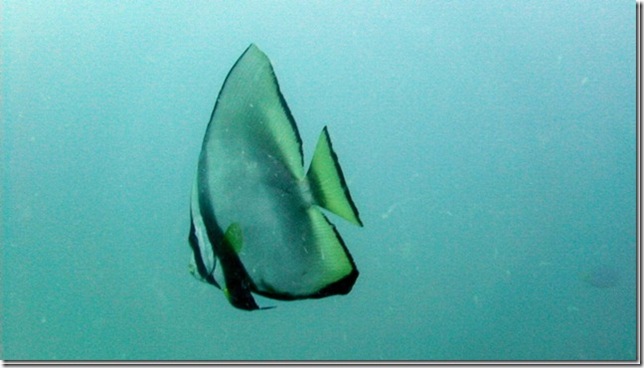
Large angelfish
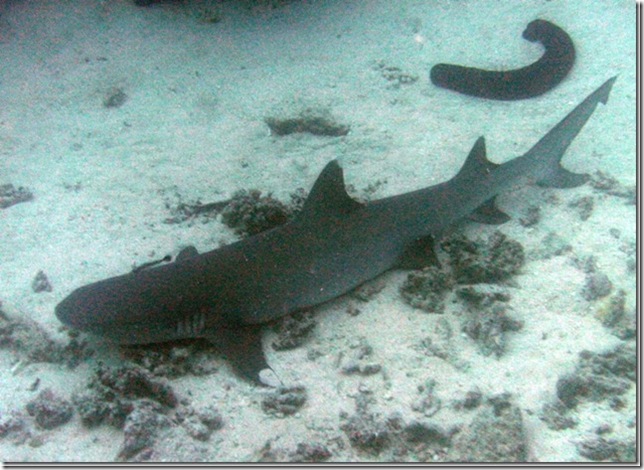 Dozing 5-foot shark and sea cucumber
Dozing 5-foot shark and sea cucumber
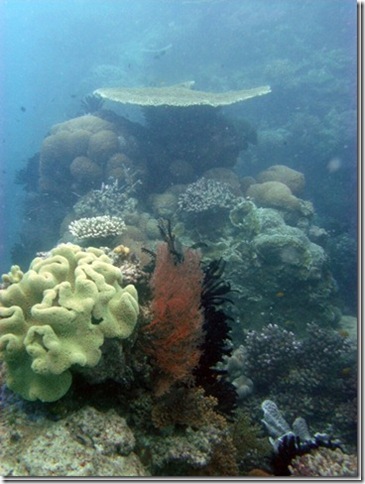 Beautiful coral near the chasm
Beautiful coral near the chasm 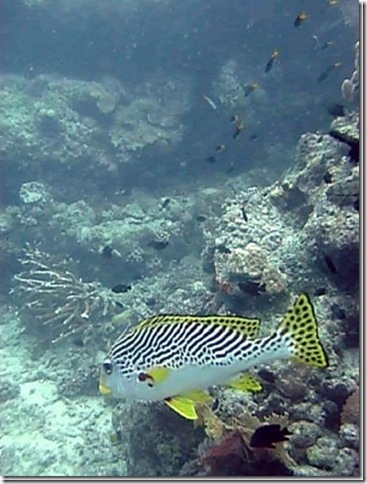 Sweetlips
Sweetlips
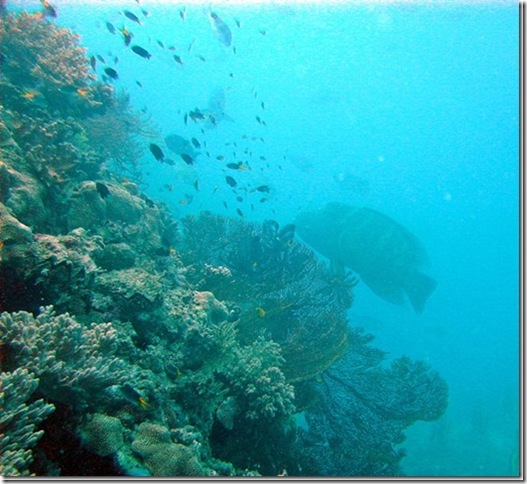 Outer reef wall with large Napolean wrasse
Outer reef wall with large Napolean wrasse
I also got another opportunity to practice navigating underwater with the compass. So far it’s worked reasonably well. I generally start out with some bearings above water and a general idea of what the underwater topology should be like (deep water to the east, etc.), then keep track of underwater landmarks and our compass heading during the dive. We usually don’t have to factor drift into the navigation, but the strength and direction of the current is a factor in terms of the route we take and how much air we save for the return trip. The fun starts when we get to around 1500 psi (out of a beginning 3000 or so) and want to get back to where we dropped down with more than 500 psi. Just like any hike, the journey back seems to go much faster as long as it’s not into the current. We’re also lucky that Lauren uses less air than anyone I’ve ever met, so I usually just have to manage my own air. It’s going to be interesting when we actually do a dive with a divemaster and commercial dive operation again and we don’t have to worry about all that stuff.
When we got back to the boat, I used the air I had left to change the sacrificial zinc on the starboard shaft, which had come loose. The zinc keeps the stray electrical current in the water from eating away the bronze prop and stainless shaft. The zinc is shaped short of like a symmetric egg with a 1” hole through middle that is then cut in half. You fit the halves over the 1” prop shaft and tighten it down with a couple of bolts. Zincs are usually $30 in NZ, but we got some from a foundry for only $10. The funny part is that zinc is zinc, so it seemed like a good deal, but the $30 ones have several features that keep them attached better – they have a couple of embedded copper balls to make good contact with the shaft, captive nuts and retaining washers for the bolts so you don’t drop either of them underwater, and lock washers so that the bolts stay tight with all the shaft vibration and rotation. I’m not sure that a couple extra washers are worth $20, but it’s much easier to hold two captive halves and an allen wrench down there instead of dealing with the wrench, two zinc halves, and two loose bolts with nuts. Anyway, for the want of a couple of lock washers the $10 zinc came loose so we now have a $30 zinc.
Even though only 5% of the GBR is completely protected, it really does seem to make a big difference in the quantity, size, and diver-friendly nature of the marine life. Each part of the reef is zoned (or unzoned) for a wide variety of uses ranging from all activities allowed to marine reserves where no sort of fishing or spearfishing is allowed. Maps of the GBR zoning for the area are free and are mandatory aboard all vessels in the GBR area.
We decided to stay put tonight and get one more night of good sleep before heading farther north toward Cape York tomorrow. Being near land at night does give us a chance to hear the sounds of some of the Australian bird life. There’s one noise that we’re assuming is a bird that’s unlike anything we’ve ever heard. I won’t even try to describe it, but it’s odd enough that you could easily imagine it being some sort of strange owl or mammal.
Lat: 14 38.846′ S
Lon: 145 27.253′ E
Well, this place is nothing short of amazing. As Dallas mentioned, the snorkeling at Normans was the best yet, and the scuba dive today was definitely among our top 5. Before I get to that, let me mention what it was like getting from point A to B.
We had a lazy morning yesterday as we let a couple of squalls pass by. By the time we left the mooring, the sun was shining and our spirits were high as we began to sail north. Our destination was the Cod Hole dive site about 110 miles away, and we decided to sail offshore rather than stay inside the reef to save time. Perhaps we would have decided differently if we had anticipated the 10′ seas and 40 knot winds that were awaiting us offshore, but probably not. We’re experienced now, and it takes more than that to scare us off. However, it takes less than that to make us uncomfortable, and we were both lethargic again. I managed to make some chili and felt much better after eating. (Dallas didn’t, but he liked the chili so much that he had some again for breakfast! Eew!) We listened to an audio book since we didn’t feel like reading, and before long, Dallas was in his usual state of slumber.
I was enjoying myself listening to music and didn’t wake him until quite late. Then it was my turn to pass out. Around 3:30, he awoke me for my watch and let me know that we were just a few miles from the reef but didn’t want to turn into it until daylight. I took this under advisement, pleased that he trusted me at the helm in such conditions, but I was pretty tired and didn’t reef the jib as soon as I should have. By the time I did, we were parallel to our destination, it was still dark, and we were still going 8 knots on only half of the jib! No harm done, though. We just had to tack back into the reef once the sun came up using only a quarter of the jib.
In such strong winds, it came as no surprise that the public mooring was available. It was kind of comical to be picking up a mooring so close to the reef in 40 knot winds, but we did it and eventually mustered up the energy to get our scuba gear on and take a look. According to our dive atlas, the Cod Hole is the "signature dive" of the GBR and is well known for large potato cod that are used to being fed and will bite at and possibly choke on your gloves if you have them on. The atlas advised not to wear gloves for this reason, but Dallas was not having that. He was not about to lose a finger to a cod just so that it would not choke on his glove!
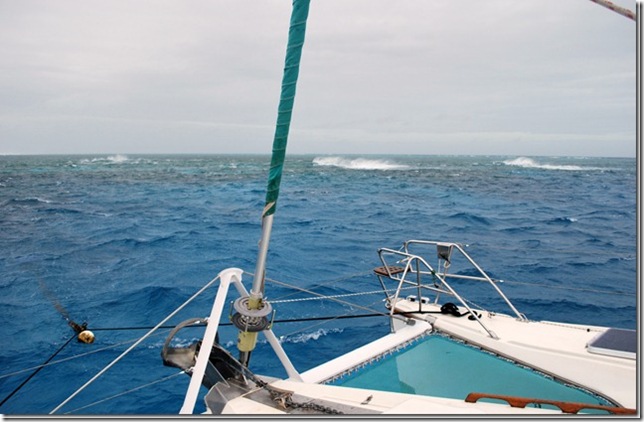 Moored along the edge of the reef
Moored along the edge of the reef
As it turned out, we saw a few of the large buggers, and it was obvious that they are used to being fed. One of largest ones (probably 4′ long and 200 pounds) was stalking us for quite a while and was not even phased by a gentle kick to the head from Dallas’ fin. Watching the way that Dallas kept his hands concealed under his arms when Mr. Potato Head was around had me cracking up. I’ve never laughed so hard into my regulator!
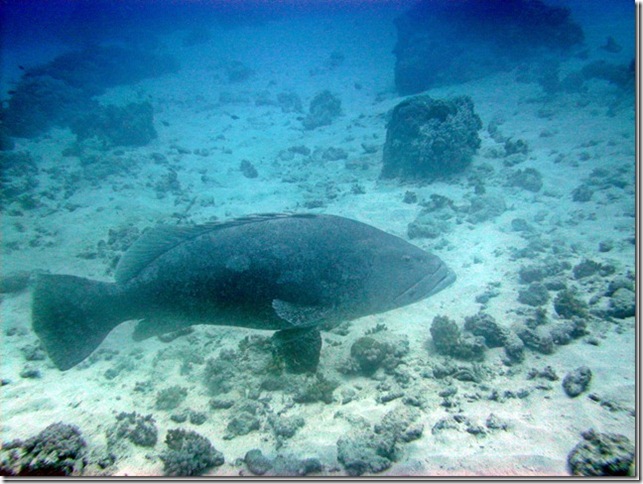 Turns out that the lens was fogged up, but you get the idea
Turns out that the lens was fogged up, but you get the idea
Besides the cod, there was an abundance of other marine life. Instead of there being one large "bommie" (coral head) like we dove on yesterday, it was just a patch of one after another, and each of them had gorgeous coral of all shapes and pastel colors and a healthy supply of fish. They were only 15-20′ underwater, so the visibility was great, and we had a nice, long dive. There were so many coral heads that I lost Dallas at one point, and it felt like we were playing Hide and Seek underwater. Dallas was off taking pictures at the time and was able to capture some nice ones that we will post when we can, probably from Darwin. (For the record, Dallas reminds me that the reason we became separated is because we came around a corner, and I got surprised by a Potato Head that was awaiting and darted off in front of it.)
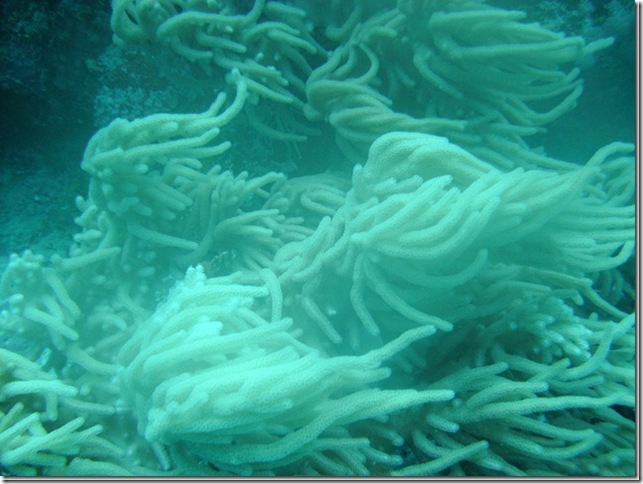 One of the many varieties of soft coral
One of the many varieties of soft coral
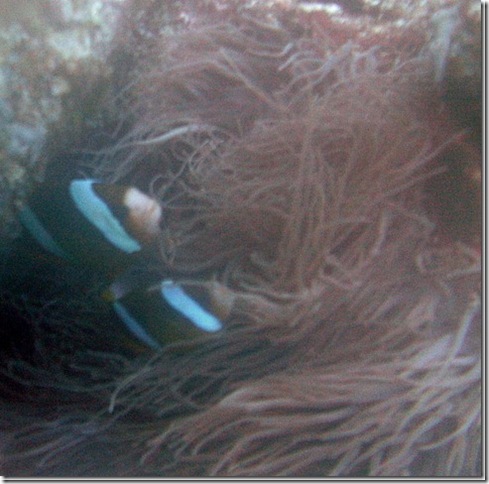 The clown anemone fish hanging out in their host anemone
The clown anemone fish hanging out in their host anemone
From Cod Hole, we sailed 15 miles to Lizard Island and now find ourselves in a beautiful little bay full of bommies with a white sandy beach. We are getting ready to head ashore for a great view and a romantic dinner. Did I mention we have the bay and beach all to ourselves?
Dallas is preparing to make some pasta for dinner. He just needs to know: 1) where the pressure cooker is stored, 2) how much water to put in, 3) where the pasta is located, 4) how much pasta to use, and 5) which sauce to use! (For the record, he decided to make his own sauce.) Each day aboard Pura Vida is an opportunity for learning something new. ;-)


